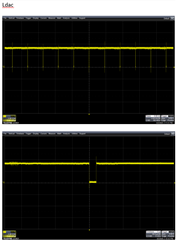Other Parts Discussed in Thread: DAC11001A
Tool/software:
Hello,
I am trying to connect BP-DAC11001EVM with ESP32. But somehow, I cannot see any output at the DAC side. My ESP 32 is establishing the communication with the DAC. But I don't see any voltage at the output. I have attached the code below that I am using. Please let me know what the issues could be.
Code:
import machine
from machine import Pin, SPI
import math
import time
# SPI Configuration
spi = SPI(1, baudrate=1000000, polarity=0, phase=0, sck=Pin(18), mosi=Pin(23))
cs = Pin(5, Pin.OUT) # Chip Select for DAC
ldac = Pin(16, Pin.OUT) # LDAC for DAC
cs.value(1)
ldac.value(1)
# Function to send 20-bit data to DAC (in 24-bit format)
def send_to_dac(cs, value):
cs.value(0)
spi.write(value.to_bytes(3, 'big'))
cs.value(1)
# Generate single-phase sine wave
def generate_sine_wave(frequency=50, amplitude=1.0, sample_rate=1000):
step = 0
while True:
# Generate a sine value between 0 and full-scale (20-bit)
sine_val = int((amplitude * (math.sin(2 * math.pi * frequency * step / sample_rate) + 1)) * ((2**20 - 1) / 2))
send_to_dac(cs, sine_val)
time.sleep_us(10) # Delay before toggling LDAC
ldac.value(0)
time.sleep_us(10) # Delay after toggling LDAC
ldac.value(1)
step = (step + 1) % sample_rate
time.sleep(1 / sample_rate)
# Start generating the signal
generate_sine_wave(frequency=50)


 This the waveform I can see across LDAC pin on EVM DAC11001. I just wanted to let you know the output.
This the waveform I can see across LDAC pin on EVM DAC11001. I just wanted to let you know the output.